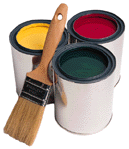
Solvents are known, used in primers, adhesives, paints and coatings. Depending on the composition they emit gases of different lengths. Volatile solvents have an irritating habit that they stink and can irritate the mucous membranes. In conventional coatings is between 50% and 70% of solvent are present. Meanwhile, the industry found it in search of a less obvious solvents and is relying increasingly on glycol.
Solvent-free paints and coatings – almost odorless
Glycols have some properties that make them suitable for use as solvents in water-based paints especially attractive in contrast to the “classical” solvents such as toluene, xylene or white spirit they mix easily with water in general. Which is for a paint in which water is the main solvent of particular importance, since the information contained in water-based paints binder actually not dissolve in water. Glycols evaporate slowly, so that the indoor air concentrations on spreading are lower than when using conventional solvents. They smell just weak and yet very different from, for example, toluene and white spirit to do so.
Glycols not need to be labeled as a solvent
Especially advantageous for the manufacturer: Due to a change in the rules of the Technical Rule No. 610 (Hazardous Substances), have chemicals with a boiling point above 200 ° C can not be characterized as a solvent. It goes even further: in water-based paints are not more than 10% glycol compounds, will be awarded to the product a well-known eco-label. A number of glycol compounds has proven in animal studies to be embryotoxic. Since the toxic metabolites of these substances after shooting only slowly excreted from the body, they can accumulate in the body during prolonged exposure. Some compounds are suspected to damage the blood count and liver and kidney.
Secondary contamination
Like the wood preservative pentachlorophenol and lindane is glycols beat down upon as secondary contamination previously unloaded walls, floors and furnishings. Remediation is slow and costly.
Sickening workplace
Solvents are used in many manufacturing processes and countless jobs. Often the protection is inadequate, and after a while come to health problems. There are no high concentrations can be achieved, so that certain solvents sensitize or cause damage to the nervous system. In the long term effect of continuous contact in the low-dose range is similar. [Source: www.csn-deutschland.de/blog/2008/04/21/chemikaliensensitivitaet-durch-loesemittel/]
Ingredients confirm in writing
Health conscious consumers can from the dealer the safety data sheets for the selected product deliver. If solvents are not explicitly declared, it is very likely that substitutes were used.
